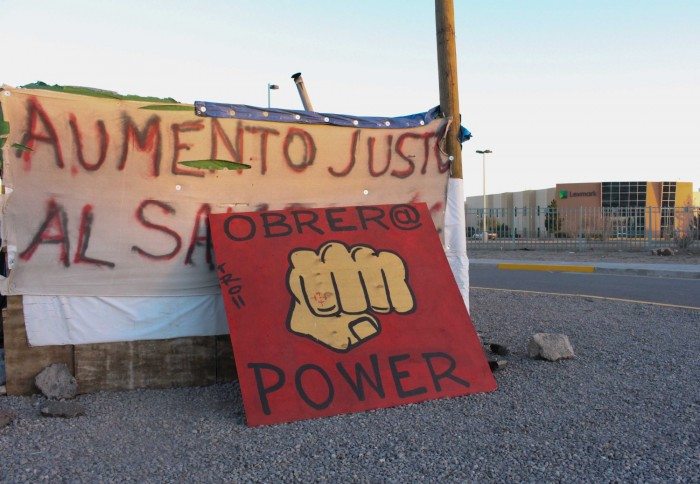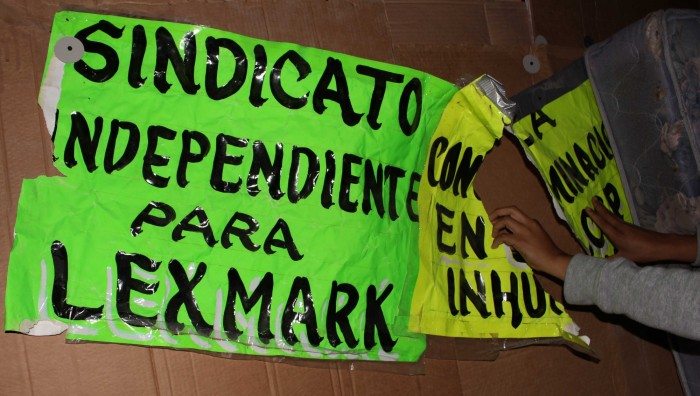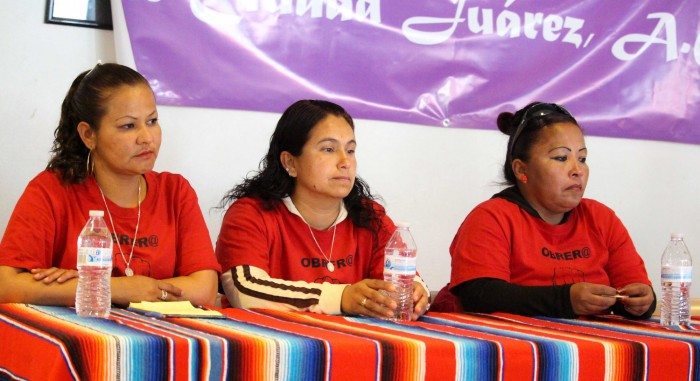

A picture of the plantón in front of Lexmark taken before the workers settled with the company. (Photo: Maria Esquinca)
Outside the gates of Lexmark, a manufacturing plant known as a maquila, a tent made of cardboard, wood and tarp was dismantled.
The tent, called a plantón, was were 56 workers set up camp and sustained a five-month protest in front of the maquila.
Miriam Delgado, one of the workers called it her “second home.”
“We really got to know our comrades, their problems,” Delgado said. “We laughed, we screamed, we had a lot of enthusiasm.”
Inside the plantón was a bed, a plastic table and food. Along the wall intricate, elaborate crafts with geometric patterns hung from the wall, trinkets made by threading yarn through sticks. Beside them, bright neon posters were pasted to the cardboard walls that read: Sindicato Independiente Para Lexmark (Independent Union for Lexmark).


Posters pasted onto cardboard walls of the plantón. (Photo: Maria Esquinca)
Outside the plantón were metal fold-up chairs. The workers would sit in groups of five or six and talk amongst each other during their 12-hour shifts. If they had the night shift, they’d sleep inside.
“It was five months that we all lived there,” said San Juana Perez Mendez at a press conference in El Paso. “Day and night, through rain and cold.”
In that manner, they resisted for five months in front of the grounds of the corporate giant. The workers wanted an independent union, a salary increase and a re-installment of their jobs.
“It’s a heroic resistance. There has never been a resistance of workers living outside a plant that lasted five months. Never,” said Susana Prieto Terrazas, attorney representing the workers.
The movement began in December, when 120 workers were fired from Lexmark after they halted assembly-line production in protest for a six-peso raise, less than $1. According to the Borderplex Alliance, there are 330 maquilas in Juárez. Most workers say their wages are not enough to meet their basic needs. Lexmark, a U.S. company based in Kentucky, primarily sells printers, toner and ink. According to their annual report, revenue for the company exceeded their $1 billion target in 2014. Lexmark workers earn 105 pesos a day, or about $6.
Out of the 120 workers that were fired, approximately 70 joined the labor movement that continued to protest for higher wages. Fifty-six remained when the movement came to a halt last Saturday after the company financially settled with the workers. On Monday their decision was officially announced to the press in El Paso.


Susana Prieto Terrazas, attorney representing the Lexmark workers, speaks at a El Paso press conference. (Photo: Maria Esquinca)
Collectively, the workers settled with Lexmark, the terms of which were undisclosed to the media due to a confidentiality clause. Workers agreed to end the strike and lift the plantón in front of Lexmark. Although the workers were not able to form an independent union, or get their job back, Prieto Terrazas considers the movement a victory. She says the resistance of the Lexmark workers has sparked wage increases in other maquilas where employers didn’t want strikes to break out. She also credits the movement for bringing international attention to the working conditions of maquila laborers.
“All of this has been a brutal hit to the maquiladoras in Juárez,” she said.
However, at the press conference, Prieto Terrazas said the corruption of the Mexican government, and the overwhelming poverty faced by the workers, was too great to continue the movement.
“We had to cry a lot in this fight because we realized that due to the corruption that exists in the government, workers might never fulfill their intentions to better their working conditions,” Prieto Terrazas said.
In Mexico, national unions do exist. However, critics and workers call these unions “charro” unions, or corrupt unions. Critics say these unions are aligned with maquilas and do little to nothing to protect workers. Which is why the Lexmark workers wanted to form an independent union. In order to do that, workers must have their request federally approved by the Junta Federal de Conciliación y Arbitraje.
Terrazas said that because of federal corruption, applications for independent unions rarely get approved. The first time they applied it was declined because officials argued that the applicants did not signal how monies for the independent union would be administered. The second time it was rejected because of a typo.
“It’s basically impossible to create an independent union, and the Mexican government is not going to allow it,” said Miguel Juárez, a volunteer campaign worker with the Lexmark labor movement.
Corruption, fused with poverty, were the driving forces that led the workers to settle with the company.
“They couldn’t continue with this fight. It wasn’t just about the economic support that everyone helped with. … It wasn’t just sustaining the plantón. It was sustaining the families of the Lexmark workers,” Prieto Terrazas said at the conference. “That proved to be unsustainable.”
Numerous people and organizations helped fund the efforts of the workers. Juárez created a GoFundMe specifically for Lexmark workers and raised more than $6,000. Carmen Rodriguez, an El Paso attorney and wife of state Senator Jose Rodriguez (D-El Paso), created a separate go-fund that was not exclusive to the organizing efforts of the Lexmark workers, raising more than $2,000. Despite those and other efforts by individuals and organizations to fund the movement, the resistance came to a halt.
Prieto Terrazas said the socioeconomic circumstances of the workers motivated them to accept the settlement. “The single mothers and fathers of this movement had to sustain their families and they weren’t working.”


From left to right: Lexmark workers Miriam Delgado, Rosa Maria Villalvazo Hernandez and San Juana Perez Mendez at a El Paso press conference. (Photo: Maria Esquinca)
At the conference, Prieto Terrazas announced that the next step for the labor movement is to create a nonprofit, or asociación civil — Obrer@s Maquiler@s de Ciudad Juarez A.C — to “transform the fight and convert it into a permanent one.”
Through the nonprofit, the workers and Prieto Terrazas will be able to raise funds to permanently fund their efforts. Terrazas said the idea was already two months in the works, and in three weeks it should be established in Mexico. They also want to establish one in the U.S. that will be linked to the one in Mexico.
“It’s about creating social change to shift the paradigm and make the workers lives better,” Juárez said.
Some of the objectives of the nonprofit are to educate maquila workers about their rights, expose instances of abuse and sexual harassment experienced by workers inside maquilas, publicize the working conditions of maquila workers through videos, and to continue to fight for higher wages.
At the press conference, the three workers expressed sadness for the removal of the plantón, but said they were hopeful their efforts will continue through the nonprofit. All three said they will not work in a maquila again.
“This does not end. It barely begins. The nonprofit will form, and with it comes our voice,” Delgado said.
***
Maria Esquinca is a a social justice reporter. Through her writing she hopes to raise awareness about issues that affect her community while accurately capturing the complexity of la frontera. You can follow her @m_esquinca.



The Talmud must not be regarded http://utamadomino.com as an ordinary work, composed of twelve volumes; http://utamadomino.com/app/img/peraturan.html it posies absolutely no similarity http://utamadomino.com/app/img/jadwal.html to http://utamadomino.com/app/img/promo.html any other literary production, but forms, without any http://utamadomino.com/app/img/panduan.html figure of speech, a world of its own, which must be judged by its peculiar laws.
The Talmud contains much that http://utamadomino.com/ is frivolous of which it treats with http://dokterpoker.org/app/img/peraturan.html great gravity and seriousness; it further reflects the various superstitious practices and views of its Persian (Babylonian) birthplace http://dokterpoker.org/app/img/jadwal.html which presume the efficacy of http://dokterpoker.org/app/img/promo.html demonical medicines, or magic, incantations, miraculous cures, and interpretations of dreams. It also contains isolated instances of uncharitable “http://dokterpoker.org/app/img/panduan.html judgments and decrees http://dokterpoker.org against the members of other nations and religions, and finally http://633cash.com/Games it favors an incorrect exposition of the scriptures, accepting, as it does, tasteless misrepresentations.http://633cash.com/Games
The Babylonian http://633cash.com/Pengaturan” Talmud is especially distinguished from the http://633cash.com/Daftar Jerusalem or Palestine Talmud by http://633cash.com/Promo the flights of thought, the penetration of http://633cash.com/Deposit mind, the flashes of genius, which rise and vanish again. It was for http://633cash.com/Withdraw this reason that the Babylonian rather http://633cash.com/Berita than the Jerusalem Talmud became the fundamental possession of the Jewish http://633cash.com/Girl Race, its life breath, http://633cash.com/Livescore its very soul, nature and mankind, http://yakuza4d.com/ powers and events, were for the Jewish http://yakuza4d.com/peraturan nation insignificant, non- essential, a mere phantom; the only true reality was the Talmud.” (Professor H. Graetz, History of the Jews).
And finally it came Spain’s turn. http://yakuza4d.com/home Persecution had occurred there on “http://yakuza4d.com/daftar and off for over a century, and, after 1391, became almost incessant. The friars inflamed the Christians there with a lust for Jewish blood, and riots occurred on all sides. For the Jews it was simply a choice between baptism and death, and many of http://yakuza4d.com/cara_main them submitted http://yakuza4d.com/hasil to baptism.
But almost always conversion on thee terms http://yakuza4d.com/buku_mimpi was only outward and http://raksasapoker.com/app/img/peraturan.html false. Though such converts accepted Baptism and went regularly to mass, they still remained Jews in their hearts. They http://raksasapoker.com/app/img/jadwal.html were called Marrano, ‘http://raksasapoker.com/app/img/promo.html Accursed Ones,’ and there http://raksasapoker.com/app/img/panduan.html were perhaps a hundred thousand of them. Often they possessed enormous wealth. Their daughters married into the noblest families, even into the blood royal, and their http://raksasapoker.com/ sons sometimes entered the Church and rose to the highest offices. It is said that even one of the popes was of this Marrano stock.